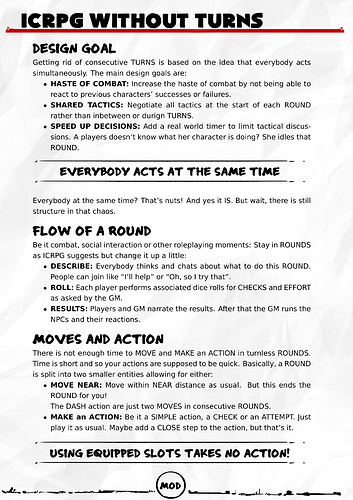Hey all,
In this post I wanted to reveal how I run combats! This method has allowed me to solve several issues I find inherent to the turn-by-turn initiative system.
I don’t like that (1) players later in the round can base their actions on things that happened earlier in the round when it’s all supposedly simultaneous, (2) players spend most of the round watching other people play their turns, or (3) having to track a billion initiative scores.
So I changed it.
I forget where I originally got the idea from, but I’ve been playing this way for a long, long time. It rocks.
The Phases Method uses combat phases. Anyone can act during a particular phase, and this means many turns are thrown into “batches” (phases) and rolled at the same time. Check them out:
1) Surprise
2) Declare actions/preparation
3) Missiles
4) Movement
5) Magic
6) Movement
7) Melee
8) Other
Surprise: ROLL FOR SURPRISE! If surprised, the force doing the surprising (ambush) gets 1 free movement and 1 free action. Then go into normal Phases.
Declaration/Preparation: Everyone declares to the GM, generally, what they’re doing. “I’m casting this spell, I’m shooting my bow, I’m charging into the fray, etc.” This is also where characters draw or stow weapons, can toss a flask of oil, etc. Enemies also declare, but I don’t tell the players.
Missiles: The opening volley, or the shots from the back lines. Assuming a ranged weapon is drawn (bow, javelin, etc.) in the prep phase, they can shoot or throw. Firing into melee has a 50% chance to hit a random target. No one is stationary in the melee.
Movement: Move a normal movement for your system.
Magic: Spells go off. This includes Turn Undead or magic item use. While preparing to cast a spell (phase 2), characters cannot take other actions. The spells are being cast from phase 2 through phase 5. If you take damage in this phase, make a check modified by damage to avoid being interrupted.
Movement: Move a normal movement for your system.
Melee: Bone crushing, toe to toe combat. If you’re engaged in melee, all non-melee actions (spells, shooting arrows, etc.) are delayed until the Other phase. If a caster is preparing a spell, but is forced into melee before it finishes casting, the spell is delayed until the Other phase.
Other: Everything else. Drink a potion, finish a spell that was delayed because you were engulfed in the melee, light a flask of oil, help a wounded ally, do a delayed action
Again: Surprise, declare, missiles, move, magic, move, melee, other.
It is possible to (1) shoot a bow (missile), (2) move (first movement phase), (3) move again into melee range (second movement phase), (4) make a melee attack (melee), and (5) drink a potion (Other). This would require you to have had a 1 handed ranged weapon (a javelin for example) and a one handed melee weapon, since you couldn’t swap weapons between phases. Yes. This means each character can do several things per round.
You could also declare a (1) spell (declare), (2) cast the spell (magic), (3) move (movement 1), and (4) make a melee attack (melee). If someone engaged YOU in melee before your spell went off in the Magic phase, though, your cast is delayed until the Other phase and other actions become impossible while you focus on holding the spell.
Yes. You read that right. Players can make multiple actions per round if they satisfy the basic requirements of the phases! More action happens, more players are involved at any given time. It’s a win win for me.
I hope you like it, throw feedback down below!
AC





 But, I do like your Moments idea (minus side-based resolution, don’t like that). Thank you for sharing.
But, I do like your Moments idea (minus side-based resolution, don’t like that). Thank you for sharing.